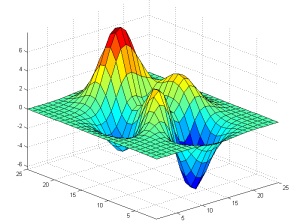
|
Homepage |
Welcome to the class website for Introduction to Numerical Analysis . Numerical approaches play an important role in many fields including in scientific research, engineering, finance, machine learning, and data analysis. This class will discuss both the mathematical foundations and the practical implementation of modern numerical methods. Examples also will be discussed from related applications areas.
Please be sure to read the prerequisites and grading policies for the class.
Topic Areas
- Approximation Theory
- Discrete Least Squares Approximation
- Orthogonal Polynomials, Chebyshev Polynomials
- Power Series, Rational Function Approximation
- Trigonometric Polynomials
- Fast Fourier Transforms
- Approximating Eigenvalues
- Orthogonal Matrices and Similarity Transformations
- The Power Method, Householder’s Method, QR Algorithm
- Singular Value Decomposition (SVD)
- Numerical Solutions of Nonlinear Systems of Equations
- Fixed Points of Functions of Several Variables
- Newton-Raphson Method
- Quasi-Newton Methods
- Steepest Descent Techniques
- Homotopy and Continuation Methods
- Boundary-Value Problems for Ordinary Differential Equations
- Shooting Methods
- Finite-Difference Methods
- The Rayleigh-Ritz Method
- Numerical Solutions to Partial Differential Equations
- Elliptic Partial Differential Equations (PDEs)
- Parabolic Partial Differential Equations (PDEs)
- Hyperbolic Partial Differential Equations (PDEs)
- Finite-Element Method (introduction)
- Application Areas
- Engineering and the Sciences
- Statistical Inference, Machine Learning, Data Science
- Computer Graphics and Visualization
- Financial Modeling and Economics
Prerequisites:
Calculus, Linear Algebra, Differential Equations, and some experience programming.
Grading:
The grade for the class will be based on the homework assignments (see policy below), midterm exam, and final exam as follows:
Homework 30%
Midterm 30%
Final Project 40%
Policies:
Homework and other assignments will be given in class and posted on the course website. Prompt submission of homeworks will be required. While no late homework will be accepted,one missed homework will be allowed without penalty. While it is permissible and encouraged for you to discuss materials with classmates, the submitted homework must be your own work.
Class Announcements:
- Midterm on Thursday, May 13.
- Midterm Outline [PDF].
- Careers in mathematics and related fields [PDF].
Supplemental Materials:
- Python: [documentation python 3.7] [general tutorial] [Codecademy]
- Numpy python package: [tutorial]
- Integrated development environments: [PyCharm]
- Jupyter Notebooks: [python interface]
- Python environment manager: [Anaconda]
- LaTeX typesetting [documentation] [summary sheet]
- Python Debugging with PDB: [Tutorial]
- Linux Operating System: [Ubuntu] [Summary Sheet] [Tutorial]
- Example Python Code:
- Neville's Method: [PDF] [Python Code] [Jupyter Notebook]
- LaTeX Table Writer: [PDF] [Python Code] [Jupyter Notebook]
Homework Assignments:
Please be sure to turn in all homeworks by 11pm PST on the due date following the instructions on the Gauchospace page. These will be graded by the TAs Yao Xuan and Andre Martins Rodrigues.
TAs Office Hours are:
Mondays 9am - 11am, Yao Xuan (see Gauchospace for zoom link)
Tuesdays 5pm-6pm, Andre Martins Rodrigues (see Gauchospace for zoom link)
Thursdays 9:30-10:30am, Andre Martins Rodrigues (see Gauchospace for zoom link)
Example python code : Neville's Method [PDF] [Python Code] [Jupyter Notebook]
Midterm Outline [PDF]
Careers in mathematics and related fields [PDF].
All problems below are from Numerical Analysis by Burden and Faires (10th edition) unless otherwise noted.
HW1: (Due April 6) 8.1: 2, 3, 5, 8, 12, 14; 8.2: 1, 3, 5, 7, 12, 13, 15;
HW2: (Due April 13) 8.3: 1ac, 3ac, 7, 9, 11, 13; 8.4: 2, 5, 7, 8ad, 10, 13;
HW3: (Due April 22) 8.5: 2, 4, 5, 9, 13, 17; 8.6: 2, 3abd, 5abd, 7, 9, 11.
HW4: (Due April 27) 9.1: 3bd, 6bc, 13, 15; 9.2: 11bc, 18, 9.3: 2ad, 4, 8, 10, 22.
Additional Information
Edit: Main | Menu | Description | Info | Image | Log-out | GS